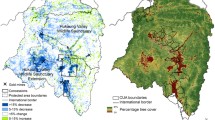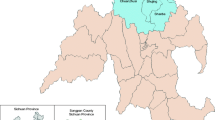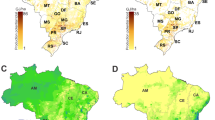Abstract
Ngorongoro Conservation Area (NCA), Tanzania, contains renowned wildlife, an expanding human population, and cultivation by Maasai agro-pastoralists and non-Maasai agriculturalists. We used integrated assessments to explore some effects of cultivation on livestock, resident wildlife, and people. Using a Landsat image from 2000, we mapped 3,967 ha [9,803 acres (ac)] of cultivation within NCA, or 39.7 km2 of the 8,283 km2 conservation area. Using integrative ecosystem (Savanna) and household (PHEWS) models, we assessed effects of: up to 50,000 ac (20,234 ha) of cultivation; cultivation concentrated into two blocks totaling 10,000 ac (4,047 ha) and 20,000 ac (8,094 ha) that may be more palatable to tourists; and human population growth. Simulations with from 10,000 to 50,000 ac in cultivation showed no large changes in ungulate populations relative to there being no cultivation. When cultivation was altered to be in two blocks, some wildlife populations changed (≤15%) and ungulate biomass remained the same. When cultivation was increased linearly with human population, poor households needed 25% of their diets to come from relief as populations tripled, because livestock could not increase significantly. Our results indicate that having <1% of NCA in cultivation, in its current distribution, is not overly detrimental to wildlife or livestock populations, and is important to Maasai well-being.







Similar content being viewed by others
References
ADDS (2001). African Data Dissemination Service, Site Version 2.3.2, US Geological Survey/EROS Data Center, Sioux Falls, South Dakota, USA. http://edcsnw4.cr.usgs.gov/adds/.
Aikman, D. I., and Cobb, S. M. (1997). Water development. In Thompson, D. M. (ed.), Multiple Land-Use: The Experience of the Ngorongoro Conservation Area, Tanzania, IUCN, Gland, Switzerland and Cambridge, UK, pp. 201–231.
Bayer, W., and Waters-Bayer, A. (1994). Forage alternatives from range and field: Pastoral forage management and improvement in the African drylands. In Scoones, I. (ed.), Living with Uncertainty: New Directions in Pastoral Development in Africa, Intermediate Technology, London, UK, pp. 58–78.
Bekure, S., de Leeuw, P. N., Grandin, B. E., and Neate, P. J. H. (1991). Maasai herding: An analysis of the livestock production system of Maasai pastoralists in eastern Kajiado District, Kenya. International Livestock Centre for Africa, ILCA Systems Study Number 4, Addis Ababa, Ethiopia.
Boone, R. B. (2000). Integrated management and assessment system: Balancing food security, conservation, and ecosystem integrity—A training manual. Global Livestock Collaborative Research Support Program, Univ. California, Davis, CA, USA. http://www.nrel.colostate.edu/projects/imas/prods/rboone/Workshop.html.
Boone, R. B., and BurnSilver, S. B. (2002). Integrated assessment results to support policy decisions in Ngorongoro Conservation Area, Tanzania. Report from the POLEYC Project to the Global Livestock Collaborative Research Support Program, University of California, Davis, California, USA.
Boone, R. B., Coughenour, M. B., Galvin, K. A., and Ellis, J. A. (2002). Addressing management questions for Ngorongoro Conservation Area, Tanzania, using the Savanna modeling system. African Journal of Ecology 40: 138–150.
Boone, R. B., Galvin, K. A., Coughenour, M. B., Hudson, J. W., Weisburg, P. J., Vogel, C. H., and Ellis, J. E. (2004). Ecosystem modeling adds value to a South African climate forecast. Climatic Change 64: 317–340.
Boone, R. B., BurnSilver, S. B., Thornton, P. K., Worden, J. S., and Galvin, K. A. (2005). Quantifying declines in livestock due to land subdivision. Range. Ecol. & Manage 58: 523–532.
Boshe, J. I. (1997). Wildlife ecology. In Thompson, D. M. (ed.), Multiple Land-Use: The Experience of the Ngorongoro Conservation Area, Tanzania, IUCN, Gland, Switzerland and Cambridge, UK, pp. 71–80.
Bourn, D. (2002). An Appraisal of Pastoral Production Potential in Relation to Continued Interventions by the Ereto Ngorongoro Pastoralist Project, Environmental Research Group Oxford, Oxford, UK.
Brown, L. H. (1973). Pastoral people and conservation. In Brown, L. H. (ed.), Conservation for survival—Ethiopia's choice, Haile Selassie, Addis Ababa, Ethiopia, pp. 67–76.
Buckley, D. J., Coughenour, M. B., Blyth, C. B., O'Leary, D. J., and Bentz, J. A. (1993). Ecosystem Management Model—Elk Island National Park: A Case Study of Integrating Environmental Models with GIS. Proceedings of the Second International Conference on Integrating GIS and Environmental Modelling. National Center for Geographic Information Analysis, University of California, Santa Barbara, California.
BurnSilver, S., Boone, R. B., and Galvin, K. A. (2003). Linking pastoralists to a heterogeneous landscape: The case of four Maasai group ranches in Kajiado District, Kenya. In Fox, J., Mishra, V., Rindfuss, R., and Walsh, S. (eds.), Linking Household and Remotely Sensed Data: Methodological and Practical Problems, Kluwer, Boston, Massachusetts, pp. 173–199.
Campbell, K., and Borner, M. (1995). Population trends and distribution of Serengeti herbivores: Implications for management. In Sinclair, A. R. E., and Arcese, P. (eds.), Serengeti II: Dynamics, Management, and Conservation of an Ecosystem, University of Chicago, Chicago, Illinois, USA, pp. 117–145.
Coughenour, M. B. (1985). Graminoid responses to grazing by large herbivores: Adaptations, exaptations, and interacting processes. Annals of the Missouri Botanical Garden 72: 852–863.
Coughenour, M. B. (1992). Spatial modelling and landscape characterization of an African pastoral ecosystem: A prototype model and its potential use for monitoring drought. In McKenzie, D. H., Hyatt, D. E., and McDonald, V. J. (eds.), Ecological Indicators, Vol. 1, Elsevier, New York, New York, pp. 787–810.
Coughenour, M. B., Ellis, J. E., and Popp, R. G. (1990). Morphometric relationships and development patterns of Acacia tortilis and Acacia reficiens in Southern Turkana, Kenya. Bulletin of the Torrey Botanical Club 117: 8–17.
De Leeuw, J., Prins, H. H. T., Njuguna, E. C., Said, M. Y. and de By, R. A. (1998). Interpretation of DRSRS animal counts (1977–1997) in the rangeland districts of Kenya. International Institute for Aerospace Survey and Earth Sciences, Enschede, The Netherlands, and the Department of Resource Surveys and Remote Sensing, Nairobi, Kenya.
Ellis, J. E., and Coughenour, M. B. (1998). The SAVANNA integrated modelling system: An integrated remote sensing, GIS and spatial simulation modelling approach. In Squires, V. R., and Sidahmed, A. E. (eds.), Drylands: Sustainable Use of Rangelands into the Twenty-First Century, IFAD Series: Technical Reports, Rome, Italy, pp. 97–106.
Fourie, J. H., and Roberts, B. R. (1977). Seasonal dry matter production and digestibility of Themeda triandra and Eragrostis lehmanniana. Agroplantae 9: 129–133.
Galvin, K., Thornton, P., and Mbogoh, S. (2000). Integrated modeling and assessment for balancing food security, conservation, and ecosystem integrity in East Africa. Final report, socio-economic modeling component, 1997–2000, Global Livestock Collaborative Research Support Program, University of California, Davis, California.
Galvin, K. A., Ellis, J., Boone, R. B., Magennis, A., Smith, N. M., Lynn, S. J., and Thornton, P. (2002). Compatibility of pastoralism and conservation? A test case using integrated assessment in the Ngorongoro Conservation Area, Tanzania. In Chatty, D., and Colchester, M. (eds.), Conservation and Mobile Indigenous Peoples: Displacement, Forced Settlement and Sustainable Development, Berghahn, New York, New York, pp. 36–60.
Gowda, J. H. (1997). Physical and chemical response of juvenile Acacia tortilis trees to browsing. Experimental Evidence. Functional Ecology 11: 106–111.
Hepinstall, J. A., Sader, S. A., Krohn, W. B., Boone, R. B., Bartlett, R. I. (1999). Development and testing of a vegetation and land cover map of Maine. Maine Agricultural and Forest Experiment Station Technical Bulletin 173, Orono, Maine.
Herlocker, D. J., Dirschl, H. J. (1972). Vegetation of the Ngorongoro Conservation Area, Tanzania. Canadian Wildlife Service, Report Series Number 19.
Hodgkinson, K. C., Ludlow, M. M., Mott, J. J., and Baruch, Z. (1989). Comparative responses of the savanna grasses Cenchrus ciliaris and Themeda triandra to defoliation. Oecologia 79: 45–52.
Homewood, K. M., Rodgers, W. A. (1991). Maasailand ecology: Pastoralist development and wildlife conservation in Ngorongoro, Tanzania. Cambridge Studies in Applied Ecology and Resource Management, Cambridge University Press, Cambridge, Massachusetts.
Homewood, K. M., Rodgers W. A., and Arhem K. (1987). Ecology of pastoralism in Ngorongoro Conservation Area, Tanzania. Journal of Agricultural Sciences 108: 57–72.
IUCN (IUCN Regional Office of East Africa) (1996). Planning for the future of Ngorongoro. Econews Afr. 5(4).
Kijazi, A. (1997). Principal management issues in the Ngorongoro Conservation Area. In Thompson, D. M. (ed.), Multiple Land-Use: The Experience of the Ngorongoro Conservation Area, Tanzania, IUCN, Gland, Switzerland and Cambridge, UK, pp. 33–43.
Kijazi, A., Mkumbo, S., and Thompson, D. M. (1997). Human and livestock population trends. In Thompson, D. M. (ed.), Multiple Land-Use: The Experience of the Ngorongoro Conservation Area, Tanzania, IUCN, Gland, Switzerland and Cambridge, UK, pp. 169–180.
Kiker, G. A. (1998). Development and comparison of savanna ecosystem models to explore the concept of carrying capacity. Ph.D. dissertation, Cornell University, Ithica, New York, New York.
Lynn, S. J. (2000). Conservation policy and local ecology: Effects on Maasai land use patterns and human welfare in northern Tanzania. M.S. thesis, Colorado State University, Fort Collins, Colorado.
Maskini, M. S., and Kidunda, R. S. (2000). Spatial and Temporal Grazing Patterns of Livestock and Wild Herbivores at Ngorongoro Conservation Area. Report to Global Livestock Collaborative Research Support Program, University of California, Davis, California.
McCabe, J. T. (1997). Risk and uncertainty among the Maasai of the Ngorongoro Conservation Area in Tanzania: A case study in economic change. Nomadic Peoples 1: 55–65
McCabe, J. T., Schofield, E. C., and Pedersen, G. N. (1997a). Food security and nutritional status. In Thompson, D. M. (ed.), Multiple Land-Use: The Experience of the Ngorongoro Conservation Area, Tanzania, IUCN, Gland, Switzerland and Cambridge, UK, pp. 285–301.
McCabe, J. T., Mollel, N., and Tumaini, A. (1997b). Food security and the role of cultivation. In Thompson, D. M. (ed.), Multiple Land-Use: The Experience of the Ngorongoro Conservation Area, Tanzania, IUCN, Gland, Switzerland and Cambridge, UK, pp. 397–416.
McNaughton, S. J. (1985). Ecology of a grazing ecosystem: The Serengeti. Ecological Monographs 55: 259–294.
Murray, M. G. (1995). Specific nutrient requirements and migration of wildebeest. In Sinclair, A. R. E., and Arcese, P. (eds.), Serengeti II: Dynamics, Management, and Conservation of an Ecosystem, University of Chicago, Chicago, Illinois, pp. 231–256.
Mwalyosi, R. B. B. (1992). Influence of livestock grazing on range condition in south-west Masailand, northern Tanzania. Journal of Applied Ecology 29: 581–588.
NCAA (Ngorongoro Conservation Area Authority) (1996). Ngorongoro Conservation Area Authority draft management plan. Tanzania Ministry of Tourism, Natural Resources, and Environment. Ngorongoro, Tanzania.
NCAA (Ngorongoro Conservation Area Authority) (1999). 1998 aerial boma count, 1999 people and livestock census, and human population trend between 1954 and 1999 in the NCA. Research and Planning Unit, Ngorongoro Conservation Area Authority, Ngorongoro Crater, Tanzania.
Ndawula-Senyimba, M. S. (1972). Some aspects of the ecology of Themeda trianda. East African Agricultural and Forestry Journal 38: 83–93.
Neumann, R. P. (1998). Imposing Wilderness: Struggles over Livelihood and Nature Preservation in Africa, University of California, Berkeley, California.
Neumann, R. P. (2000). Land, justice, and the politics of conservation in Tanzania. In Zerner, C. (ed.), People, Plants, and Justice: The Politics of Nature Conservation, Columbia University Press, New York, New York, pp. 117–133.
Norton-Griffiths, M. (1979). The influence of grazing, browsing, and fire on the vegetation dynamics of the Serengeti. In Sinclar, A. R. E., and Norton-Griffiths, M. (eds.), Serengeti: Dynamics of an Ecosystem, University of Chicago, Chicago, Illinois, pp. 310–352.
O'Connor, T. G. (1994). Composition and population responses of an African savanna grassland to rainfall and grazing. Journal of Applied Ecology 31: 155–171.
O'Connor, T. G., Pickett, G. A. (1992). The influence of grazing on seed production and seed banks of some African savanna grasslands. Journal of Applied Ecology 29: 247–260.
Perkin, S. (1995). Multiple land use in the Serengeti region: The Ngorongoro Conservation Area. In Sinclair, A. R. E., and Arcese, P. (eds.), Serengeti II: Dynamics, Management, and Conservation of an Ecosystem, University of Chicago, Chicago, Illinois, pp. 571–587.
Runyoro, V. A. (1998). Research and ecological monitoring: Annual report. Ngorongoro Conservation Area Authority, Ngorongoro Crater, Tanzania.
Runyoro, V. A., Hofer, H., Chausi, E. B., Moehlman, P. D. (1995). Long-term trends in the herbivore populations of Ngorongoro Crater, Tanzania. In Sinclair, A. R. E., and Arcese, P. (eds.), Serengeti II: Dynamics, Management, and Conservation of an Ecosystem, University of Chicago, Chicago, Illinois, pp. 146–168.
Rwambo, P., Grootenhuis, J. G., Demartini, J., Mkumbo, S. (1999). Animal Disease Risk in the Wildlife/Livestock Interface in the Ngorongoro Conservation Area of Tanzania, Report to Global Livestock Collaborative Research Support Program, University of California, Davis, California.
Rykiel, E. J. (1996). Testing ecological models: The meaning of validation. Ecological Modelling 90: 229–244.
Satorre, E. H., Rizzo, F. A., Arias, S. P. (1996). The effect of temperature on sprouting and early establishment of Cynodon dactylon. Weed Research 36: 431–440.
Seagle, S. W., McNaughton, S. J. (1993). Simulated effects of precipitation and nitrogen on Serengeti grassland productivity. Biogeochemistry 22: 157–178.
Serneels, S., Lambin, E. F. (2001). Impact of land-use changes on the wildebeest (Connochaetes taurinus) in the northern part of the Serengeti-Mara ecosystem. Journal of Biogeography 28: 391–408.
Sinclair, A. R. E., Gwynne, M. D. (1972). Food selection and competition in the East African buffalo (Syncerus caffer Sparrman). East African Wildlife Journal 10: 77–89.
Society of Range Management (1989). A Glossary of Terms Used in Range Management, Denver, Colorado.
Stafford Smith, D. M., Noble, I. R., Jones, G. K. (1985). A heat balance model for sheep and its use to predict shade-seeking behaviour in hot conditions. Journal of Applied Ecology 22: 753–774.
Tapson, D. (1997). The effects of drought on livestock on communally managed rangelands. Rural Transformation Services, Bathurst, Eastern Cape, Republic of South Africa.
Tewari, V. P. (1996). Developing equations for estimating growth parameters of Acacia tortilis (Forsk.) Hayne. Indian Forester 122: 1004–1009.
Thompson, D. M. (ed.) (1997). Multiple Land-Use: The Experience of the Ngorongoro Conservation Area, Tanzania, IUCN, Gland, Switzerland and Cambridge, UK.
Thornton P. K., Galvin, K. A., Boone, R. B. (2003). An agro-pastoral household model for the rangelands of East Africa. Agricultural Systems 76: 601–622.
UNESCO (United Nations Educational, Scientific, and Cultural Organization) (2000). UNESCO MAB biosphere reserve directory. http://www.unesco.org/mab/brlistAfr.htm.
USDA (U.S. Department of Agriculture) (2003). Natural Resources Conservation Service: World soil resources. Washington, DC, USA. http://www.nrcs.usda.gov/technical/worldsoils/.
VITO (VITO Belgium) (2002). Vegetation home page and catalogue. http://www.vgt.vito.be/indexstart.htm.
Weisberg, P. J., Hobbs, N. T., Ellis, J. E., Coughenour, M. B. (2002). An ecosystem approach to population management of ungulates. Journal of Environmental Management 65: 181–197.
Western, D. (1975). Water availability and its influence on the structure and dynamics of a savanna large mammal community. East African Wildlife Journal 13: 265–286.
Acknowledgments
V. Runyoro assisted with mapping cultivation, and with outreach efforts. Discussions with S. BurnSilver and S. Lynn greatly improved the research. Our thanks to E. Chausi for posing the questions addressed by the research team, P. Moehlman for providing data, and to members of the Maasai community who provided input. This publication was made possible through funding provided to M. Coughenour, J. Ellis, and K. Galvin by the Global Livestock Collaborative Research Support Program, supported by the Office of Agriculture and Food Security, Global Bureau, United States Agency for International Development under Grant No. PCE-G-98-00036-00, and by support from the US National Science Foundation Biocomplexity program to N.T. Hobbs et al. under grant 0119618.
Author information
Authors and Affiliations
Corresponding author
Rights and permissions
About this article
Cite this article
Boone, R.B., Galvin, K.A., Thornton, P.K. et al. Cultivation and Conservation in Ngorongoro Conservation Area, Tanzania. Hum Ecol 34, 809–828 (2006). https://doi.org/10.1007/s10745-006-9031-3
Published:
Issue Date:
DOI: https://doi.org/10.1007/s10745-006-9031-3




